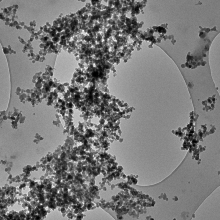Particles at the nanoscale exhibit a significant sensitivity to small size changes and may posses altered physical and chemical properties (e.g. catalytic activity, optical and electric properties, supermagnetism) compared to the same material at the macroscale. For the production of nanoparticles with well-defined, tailor-made properties a detailed understanding of the particle formation process is required, which can be obtained by detailed numerical simulations. A commonly employed method for nanoparticle production is flame synthesis and this project aims to develop an accurate modelling framework for nanoparticle flame synthesis. We extend an advanced modelling concept for turbulence-chemistry interaction called multiple mapping conditioning (MMC) to flame synthesis processes. A stochastic sparse-Lagrangian MMC formulation is enhanced to account for particle nucleation, surface growth and agglomeration. The MMC model is developed in the context of the large eddy simulation (LES) paradigm for turbulent flows. In a first step the feasibility of modelling particle nucleation in MMC is demonstrated by validating the MMC model results against custom-made DNS data of silica nanoparticle formation in a double mixing layer. Subsequently the model is extended to also account for surface growth and agglomeration and employed in a fully coupled MMC-LES framework. The results from MMC-LES are compared to detailed laser diagnostics, namely elastic light scattering (ELS) and laser-induced fluorescence (LIF), conducted on a turbulent jet doped with silane issuing into a hot vitiated coflow. The project aims to jointly advance numerical and experimental research methods by computing predicted experimental signals that can be directly compared to the raw laser data.
Movie 1
Movie 1: Dispersion of the stochastic particles coloured by the number density of primary particulates [#/m³] (left). Time evolution of the particulate size distribution (PSD) on a tracked stochastic particle (right). The particulate size distribution is altered due to inception, volumetric surface growth and agglomeration.
Related publications
- G. Neuber, A. Kronenburg, O. T. Stein, C. E. Garcia, B. A. O. Williams, F. Beyrau, and M. J. Cleary, “Sparse-Lagrangian PDF Modelling of Silica Synthesis from Silane Jets in Vitiated Co-flows with Varying Inflow Conditions,” Flow, Turbul. Combust., vol. 106, pp. 1167–1194, (2021).
- G. Neuber, C. E. Garcia, A. Kronenburg, B. A. O. Williams, F. Beyrau, O. T. Stein, and M. J. Cleary, “Sparse-Lagrangian PDF modelling of particulate flame synthesis in turbulent reacting flows,” in Proc. 11th Medit. Combust. Symp., Tenerife, Spain, (2019).
- G. Neuber, C. E. Garcia, A. Kronenburg, B. A. O. Williams, F. Beyrau, O. T. Stein, and M. J. Cleary, “Joint experimental and numerical study of silica particulate synthesis in a turbulent reacting jet,” Proc. Combust. Inst., vol. 37, pp. 1213–1220, (2019).
- S. Galindo-Lopez, F. Salehi, M. J. Cleary, A. R. Masri, G. Neuber, O. T. Stein, A. Kronenburg, A. Varna, E. R. Hawkes, B. Sundaram, A. Y. Klimenko, and Y. Ge, “A Stochastic Multiple Mapping Conditioning Computational Model in OpenFOAM for Turbulent Combustion,” Computers & Fluids, vol. 172, pp. 410–425, (2018).
- S. Vo, A. Kronenburg, O. T. Stein, and M. J. Cleary, “Multiple mapping conditioning for silica nanoparticle nucleation in turbulent flows,” Proc. Combust. Inst., vol. 36, pp. 1089–1097, (2017).
- S. Vo, A. Kronenburg, O. T. Stein, and M. J. Cleary, “Large eddy simulation of nanoparticle nucleation using multiple mapping conditioning,” in Proc. 8th Europ. Combust. Meeting, Dubrovnik, Croatia, (2017).
Contact

Andreas Kronenburg
Univ.-Prof. Dr.Director of the Institute



